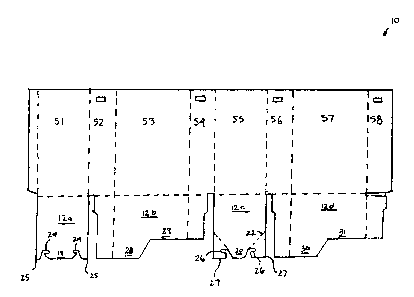Some of the information on this Web page has been provided by external sources. The Government of Canada is not responsible for the accuracy, reliability or currency of the information supplied by external sources. Users wishing to rely upon this information should consult directly with the source of the information. Content provided by external sources is not subject to official languages, privacy and accessibility requirements.
Any discrepancies in the text and image of the Claims and Abstract are due to differing posting times. Text of the Claims and Abstract are posted:
| (12) Patent: | (11) CA 2462249 |
|---|---|
| (54) English Title: | BOX FLAP LOCKING SYSTEM |
| (54) French Title: | SYSTEME DE VERROUILLAGE DE RABAT DE BOITE |
| Status: | Expired and beyond the Period of Reversal |
| (51) International Patent Classification (IPC): |
|
|---|---|
| (72) Inventors : |
|
| (73) Owners : |
|
| (71) Applicants : |
|
| (74) Agent: | MARKS & CLERK |
| (74) Associate agent: | |
| (45) Issued: | 2009-06-23 |
| (22) Filed Date: | 2004-03-29 |
| (41) Open to Public Inspection: | 2005-01-15 |
| Examination requested: | 2006-02-20 |
| Availability of licence: | N/A |
| Dedicated to the Public: | N/A |
| (25) Language of filing: | English |
| Patent Cooperation Treaty (PCT): | No |
|---|
| (30) Application Priority Data: | |||||||||
|---|---|---|---|---|---|---|---|---|---|
|
The invention provides a foldable box design having a box flap locking system, comprising: a first flap having an edge with a generally trapezoidal shaped tab cut therein, wherein said generally trapezoidal shaped tab is defined by two inwardly projecting grooves; and a second flap that locks with the first flap, wherein the second flap includes an edge with a second generally trapezoidal shaped tab cut therein, and wherein said second generally trapezoidal shaped tab is defined by two outwardly projecting grooves.
L'invention, une boîte pliable à système de verrouillage de rabat de boîte comprenant un premier rabat ayant un rebord dans lequel une languette généralement trapézoïdale est découpée, la languette généralement trapézoïdale est délimitée par deux rainures vers l'intérieur; et un second rabat se verrouille dans le premier rabat, le second rabat comprend un rebord dans lequel une languette généralement trapézoïdale est découpée, la languette généralement trapézoïdale est délimitée par deux saillies vers l'extérieur.
Note: Claims are shown in the official language in which they were submitted.
Note: Descriptions are shown in the official language in which they were submitted.

2024-08-01:As part of the Next Generation Patents (NGP) transition, the Canadian Patents Database (CPD) now contains a more detailed Event History, which replicates the Event Log of our new back-office solution.
Please note that "Inactive:" events refers to events no longer in use in our new back-office solution.
For a clearer understanding of the status of the application/patent presented on this page, the site Disclaimer , as well as the definitions for Patent , Event History , Maintenance Fee and Payment History should be consulted.
| Description | Date |
|---|---|
| Time Limit for Reversal Expired | 2022-09-29 |
| Letter Sent | 2022-03-29 |
| Letter Sent | 2021-09-29 |
| Letter Sent | 2021-03-29 |
| Common Representative Appointed | 2019-10-30 |
| Common Representative Appointed | 2019-10-30 |
| Inactive: Late MF processed | 2017-04-03 |
| Letter Sent | 2017-03-29 |
| Grant by Issuance | 2009-06-23 |
| Inactive: Cover page published | 2009-06-22 |
| Pre-grant | 2009-03-06 |
| Inactive: Final fee received | 2009-03-06 |
| Notice of Allowance is Issued | 2008-11-18 |
| Letter Sent | 2008-11-18 |
| Notice of Allowance is Issued | 2008-11-18 |
| Inactive: Approved for allowance (AFA) | 2008-10-28 |
| Amendment Received - Voluntary Amendment | 2007-12-11 |
| Inactive: S.30(2) Rules - Examiner requisition | 2007-06-11 |
| Amendment Received - Voluntary Amendment | 2006-08-21 |
| Letter Sent | 2006-03-09 |
| Request for Examination Requirements Determined Compliant | 2006-02-20 |
| All Requirements for Examination Determined Compliant | 2006-02-20 |
| Request for Examination Received | 2006-02-20 |
| Letter Sent | 2005-06-01 |
| Inactive: Correspondence - Transfer | 2005-03-23 |
| Application Published (Open to Public Inspection) | 2005-01-15 |
| Inactive: Cover page published | 2005-01-14 |
| Inactive: Office letter | 2004-08-31 |
| Inactive: Single transfer | 2004-07-27 |
| Inactive: Correspondence - Formalities | 2004-06-08 |
| Inactive: First IPC assigned | 2004-05-16 |
| Inactive: IPC assigned | 2004-05-16 |
| Inactive: Courtesy letter - Evidence | 2004-05-04 |
| Inactive: Filing certificate - No RFE (English) | 2004-04-28 |
| Filing Requirements Determined Compliant | 2004-04-28 |
| Application Received - Regular National | 2004-04-28 |
There is no abandonment history.
The last payment was received on 2009-03-27
Note : If the full payment has not been received on or before the date indicated, a further fee may be required which may be one of the following
Please refer to the CIPO Patent Fees web page to see all current fee amounts.
Note: Records showing the ownership history in alphabetical order.
| Current Owners on Record |
|---|
| NORAMPAC SCHENECTADY, INC. |
| Past Owners on Record |
|---|
| THOMAS WEST |